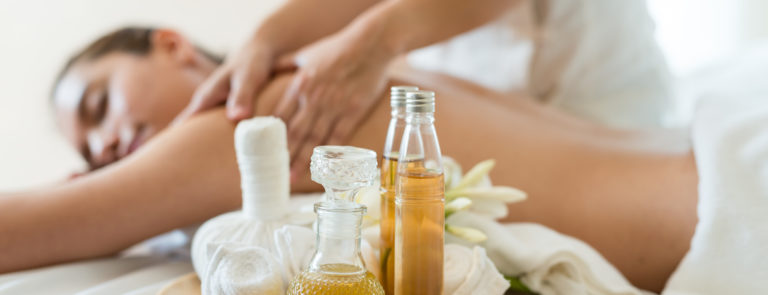10% off £35
Code:SAVE
How to use massage oils

A relaxing or reviving massage is made better with the addition of aromatherapy oils. Find out more.
From anxiety to muscle soreness, massage can help ease some of the physical and emotional factors associated with a stressful life. Whether performed on yourself or a loved one, the act of giving a massage can help soothe aches while offering a valuable moment of calm.
What can massage help with?
Massage is wonderful for both the body and mind.Body
Sore, tired or aching muscles benefit from massage, with reduced soreness and increased range of motion among the potential benefits. 1 Massage can also help to manage muscle recovery following a muscle injury. Massage encourages healthy circulation to the muscles, which causes blood to rush to these areas, delivering oxygen and vital nutrients such as calcium and iron. 2 Further, a deep tissue massage can help break down muscle adhesions, knots and even scar tissue which can form after muscle injury. 3Mind
A massage promotes relaxation, calm and emotional wellbeing. In some studies, it has shown to be beneficial in helping reduce the feelings of depression. 4 Massage has been known to reduce levels of cortisol (the so-called ‘stress hormone’) in the body and increase levels of both dopamine and serotonin (known as the ‘happy hormones’). 5 Many different parts of the body can benefit from massage. Particularly effective areas include the back, neck, scalp hands and feet.Different types of massage oils available
From olive oil to coconut oil, massage is made easier and more pleasant with the addition of an oil. This is for two reasons1. A smoother, more comfortable massage
Using an oil allows the hands to glide over the skin during the massage and give a more relaxing experience. Long strokes such as the effleurage technique (designed to warm up the body’s muscle tissues) and petrissage (a kneading movement) are more comfortable with an oil, as the hands won’t drag on well-lubricated skin.2. The extra benefit of aromatherapy
Massage oils offer the additional benefit of delivering aromatherapy to both the giver and recipient of the massage. Certain essential oils, such as lavender, have shown to enhance the relaxing benefits of a massage. 6What makes a good massage oil?
A good massage oil allows your hands to glide over the skin, without becoming sticky or drying out. Your massage oil should have a fragrance you like (or be scent-free if you prefer), be non-irritating to the skin and not stain clothes or bed linen. You can easily make your own aromatherapy massage oil blend. First, choose a base massage oil, or ‘carrier’ oil. This is the main component of your blend and should be something affordable, gentle on the skin and non-sticky. Good choices are sweet almond oil for massage, as well as coconut oil, jojoba oil, grapeseed oil, argan oil and even olive oil from the kitchen cupboard. Essential oils for massage areOur top pick
1. Grapeseed oil
A grapeseed oil massage will deliver essential fatty acids and vitamin E to the skin, nourishing it while providing the perfect lubricant for massage. With a neutral aroma, grapeseed oil is an ideal carrier oil to which you can add a few drops of your favourite essential oil. Alternatively, it can be used alone.2. Arnica oil
This arnica massage oil includes a base of olive and sunflower seed oils with extracts of organic arnica flower. Arnica flower is renowned for its skin-soothing effects.7 Arnica massage oil soothes with a gentle warming effect.8 This arnica massage oil is the perfect base to create your own blend. Add a few drops of essential oil to personalise it to your preferences3. Lavender oil
Lavender massage oil is a perfect way to deliver the well-known benefits of this calming herb. Linked with a reduction in anxiety, stress and depression,9 lavender oil coupled with massage is a match made in relaxation heaven. Incorporating jojoba and chamomile oils, this moisturising oil is perfect for an evening massage to help promote sleep.How to massage using a massage oil
Apply a few drops to your hands and rub your hands together to warm the oil before applying your hands to the skin. This ensures your hands won’t be too cold when coming into contact with the person’s skin. Last updated: 28th September 2020Sources
Related Articles
Shop by wellness goal
Sign up for exclusive offers
Plus, get expert advice to support your health & wellness straight to your inbox when you sign up to Holland & Barrett emails.
Read our
privacy policy














